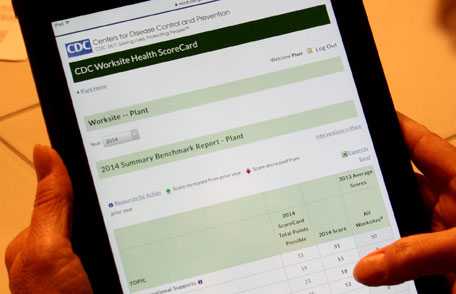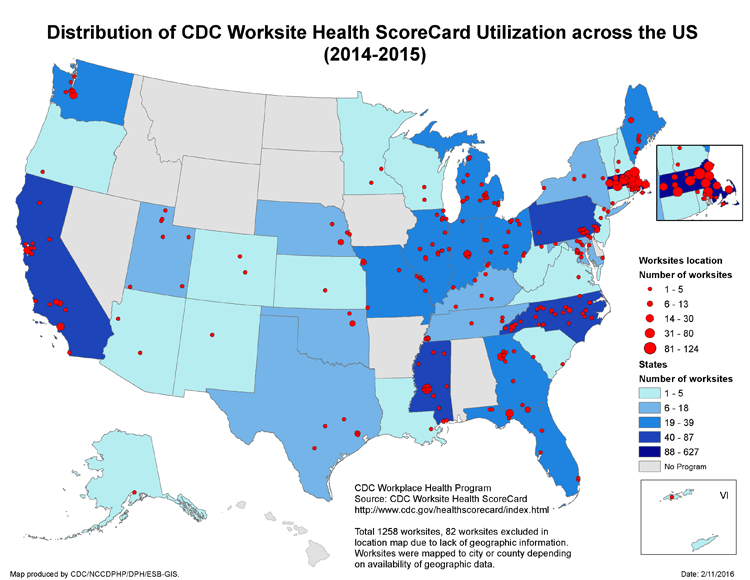Using the CDC Worksite Health ScoreCard
 Measure the success of your worksite health promotion program.
Measure the success of your worksite health promotion program.
Use this free, online tool to measure the health of your workforce, and evaluate workplace efforts to help employees improve their health.
Workplace health promotion programs are becoming more popular. However, these programs are not always well-designed using the best available scientific evidence.
CDC developed the Worksite Health ScoreCard to help employers measure how proven, science-based health promotion strategies can be used in their worksites. These strategies include:
- lifestyle counseling.
- physical and/or social environmental changes (supports) like stairwell enhancement or onsite fitness facilities.
- policies like tobacco-free campuses.
- health plan benefits.
- other worksite programs shown to promote healthy lifestyles and prevent chronic disease like walking clubs.
Why is the ScoreCard an important tool?
- The ScoreCard helps employers identify program gaps and links them to tools and resources to close those gaps.
- The ScoreCard can be used to assist in prioritizing where workplace health promotion resources and efforts could be focused.
Who is using the ScoreCard?
- Over 1,200 ScoreCards have been submitted to CDC from employers from 40 states.
- Most (82%) employers using the ScoreCard have 100 employees or less.
- 72% of employers are private, for profit businesses, 19% are government, and 9% are nonprofit organizations.
What are employers doing?
Of employers using the online ScoreCard:
- 92% report providing coverage with no or low out-of-pocket costs for flu vaccination.
- 73% report providing coverage with no or low out-of-pocket costs for blood pressure control medications.
- 69% report having a written policy banning tobacco use.
- 52% report subsidizing or discounting the cost of on-site or off-site exercise facilities.
- 41% report providing educational seminars, workshops, or classes on nutrition.
- 38% report providing free or subsidized self-management programs for weight management.
Prevalence of health promotion intervention strategies in worksites by type, 2014-2016 (n=1,258)
| Strategy Type | Worksites | Percent |
|---|---|---|
|
Program |
822 |
65% |
|
Policy |
1151 |
91% |
|
Benefit |
820 |
65% |
|
Environmental Supports |
523 |
42% |
| Source: CDC Worksite Health ScoreCard Online | ||
- Few worksites (28%) use a comprehensive approach that includes all four intervention (program, policy, benefit, and environmental support) strategies to address employee health risks.
Number of worksites implementing comprehensive workplace health promotion programs, 2014-2016 (n=1258)
| Worksites | Percent | |
|---|---|---|
|
One strategy type* only |
147 |
12% |
|
Any combination of two strategy types only |
321 |
26% |
|
Any combination of three strategy types only |
437 |
35% |
|
All four strategy types |
353 |
28% |
| Source: CDC Worksite Health ScoreCard Online *Represents program, policy, benefit, or environmental support. Percentages may not add to 100% due to rounding |
||
How have employers used ScoreCards to improve workplace health programs?
Several employers who have participated in CDC workplace health programs have used the ScoreCard on an annual basis. Examples include:
- Building an employee vegetable garden [487 KB] at the worksite, which provided healthy produce, physical activity, and stress management opportunities for employees.
- Introducing fun challenges combined with other physical activity strategies through a corporate Olympics [469 KB] to support employees making healthy lifestyle changes.
- Ensuring company catered lunches and meals [422 KB] include a healthy option.
- Making stairwells [524 KB] more attractive through carpeting and motivational signage so employees will use them more often.

More Information
More Information
- Learn more about CDC’s Workplace Health Program and tools and resource for employers
- CDC Workplace Health Promotion Website
- CDC Worksite Health ScoreCard including a user guide and five video tutorial describing how to establish an account, complete, and submit a ScoreCard
- Workplace Health Promotion At A Glance 2015
- CDC Foundation Business Pulse: Good Health is Good Business: How CDC contributes to a safer, healthier workforce
- Page last reviewed: March 25, 2016
- Page last updated: March 25, 2016
- Content source:
- National Center for Chronic Disease Prevention and Health Promotion, Division of Population Health
- Page maintained by: Office of the Associate Director for Communication, Digital Media Branch, Division of Public Affairs




 ShareCompartir
ShareCompartir